NDVI stands for "Normalized Difference Vegetation Index". NRG stands for "Near-infrared / Red / Green". NDVI and NRG are both ways to visualize the amounts of infrared and other wavelengths of light reflected from vegetation. Because both these methods compare ratios of blue and red light absorbed versus green and IR light reflected, they can be used to evaluate the health of vegetation. It's a snapshot of how much photosynthesis is happening. This is helpful in assessing vegetative health or stress. (Read more here: https://www.agronomy.org/publications/jeq/articles/36/3/832) ## Do-It-Yourself These techniques for vegetation analysis were developed for satellite imagery, but at Public Lab, we've been working a lot on capturing infrared imagery using our DIY [near-infrared camera](/wiki/near-infrared-camera) setup, and combining it with visible bands to produce NDVI images such as the one above. ## What these images mean What exactly are these images we're trying to make? What do they tell us about vegetation, and why? These diagrams should help to understand what it is we're doing and why these are good ways to analyze plant life. ## The NDVI equation [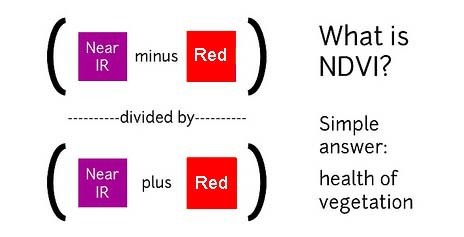](/i/44723) **NDVI = (Near Infrared - Red)/(Near Infrared + Red)** NDVI is a ratio which tries to emphasize photosynthesis while filtering out sun glare. The above equation is run for every pixel, using source data from an infrared photo and a visible light photo, like this pair: [](https://publiclab.org/system/images/photos/000/021/771/original/5390895115_c9d4d38fec_o.jpg) The result can be false-colored to make the high-photosynthesis areas more clear, and used to examine where plants are and how healthy they are. [](https://publiclab.org/system/images/photos/000/021/770/original/PetVISNDVIcomp.png) _Figure above: Normal color photo (right) and normalized difference vegetation index (NDVI) image (left). NDVI image was derived from two color channels in a single photo taken with a camera modified with a special infrared filter. Note that tree trunks, brown grass, and rocks have very low NDVI values because they are not photosynthetic. Healthy plants typically have NDVI values between 0.1 and 0.9. -- @cfastie_ ### Activities Here are a range of activities you can do to produce and interpret your own NDVI imagery, whether downloaded from a satellite imagery provider or [collected yourself using a DIY technique](/wiki/multispectral-imaging) [activities:ndvi] ****   Most DIY converted cameras today (those from Public Lab) use RGN instead of NRG, so the blue channel represents infrared instead of the red channel. That looks like this: [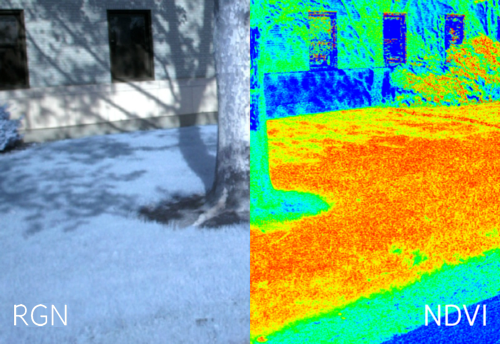](/i/45468?s=o) **** ## NRG imagery Some people are also interested in producing NRG imagery (like the below image), where `Near-Infrared, Red, and Green` are used to compose a picture instead of the usual `Red, Green, and Blue`. [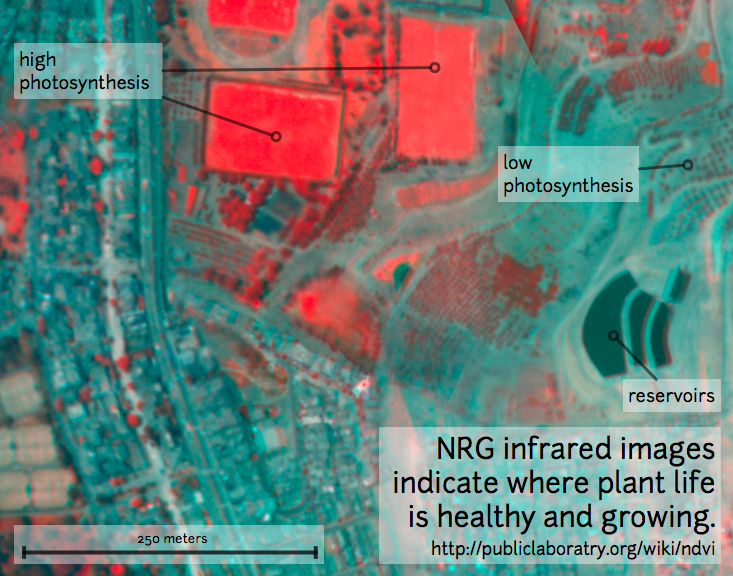](/i/25064) This diagram explains the swapping, which allows us to 'see' infrared as if it were a normal color: [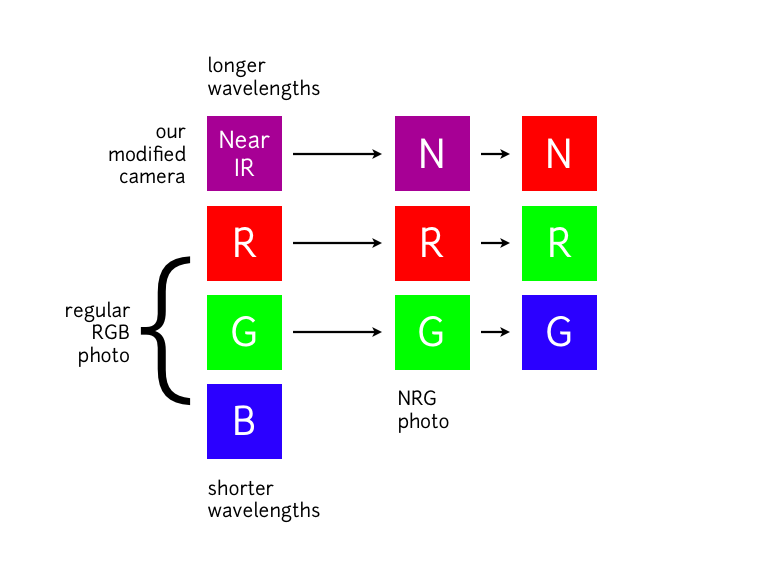](/i/25063) **In NRG images, the deeper and clearer the red color, the denser and healthier the vegetation (more or less).** ### Questions [questions:ndvi] ### Other examples of DIY NDVI imaging From around the internet: Begin watching at 2 minutes to see the resulting imagery: *This topic is part of the [Grassroots Mapping Curriculum](/wiki/mapping-curriculum) series.* **** [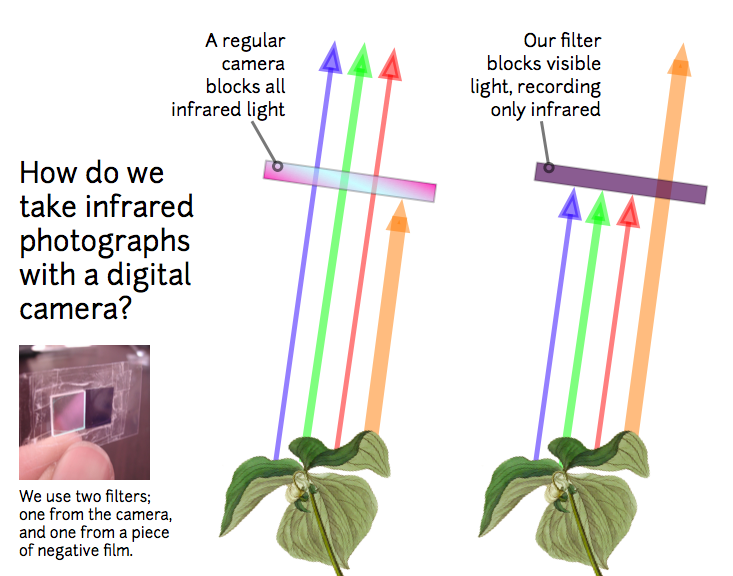](/i/25066) [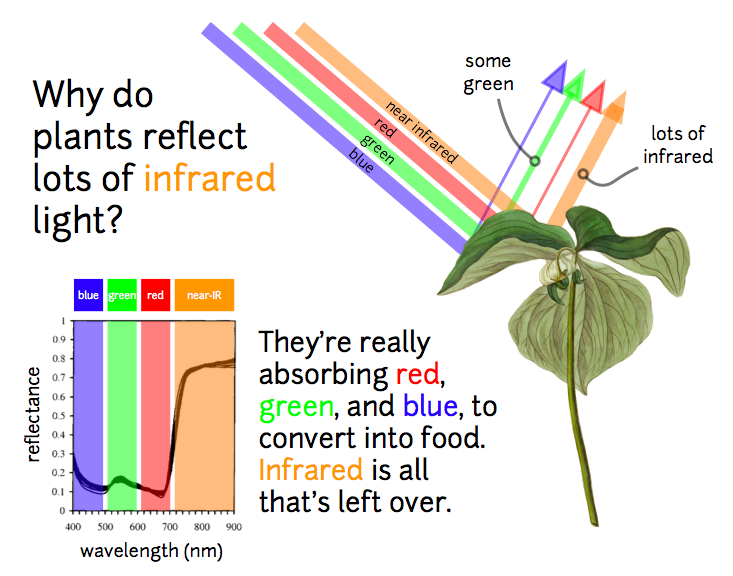](/i/25065) ...
| Author | Comment | Last activity | Moderation | ||
|---|---|---|---|---|---|
| Ag8n | "If you are using the public lab spectrometer, a light source for around 400 nm is needed. It looks like there are some blue or violet led bulbs/ f..." | Read more » | over 2 years ago | |||
| Ag8n | "A test of this method might be to use lawn clippings and run it through the procedure. The idea is to extract chlorophyll, which should be presen..." | Read more » | over 2 years ago | |||
| Ag8n | "Another, more current option , is to use a coffee grinder. With the temperature issues this material shows, probably using the frozen state would ..." | Read more » | over 2 years ago | |||
| Ag8n | "As for the mortar and pestle, there are many options. Some mortar and pestles are very expensive, but they don't have to be. They should be easy t..." | Read more » | over 2 years ago | |||
| Ag8n | "Was checking one of the online vendors. Found new centrifuges for $70. Industrial quality centrifuge costs were much higher, but who knows. If y..." | Read more » | over 2 years ago | |||
| Ag8n | "Ok. Trying to stay as close to duplicate the original paper as closely as possible. R.la cera isn't in this area. But other closely related liche..." | Read more » | over 2 years ago | |||
| Ag8n | "One word of warning. Solvents ( like acetone) and plastic cuvettes do not usually go together. The worst case is the plastic melts, but the plast..." | Read more » | over 2 years ago | |||
| Ag8n | "Still have to do more work. But the acetone extract seems like something that might be doable in a home lab type situation. The acetone extract i..." | Read more » | over 2 years ago | |||
| fongvania | "There's some work needed to modify this research protocol so it can be done in regions like Ohio that might not have the exact species listed in th..." | Read more » | over 2 years ago | |||
| fongvania | "I don't know of a community science project using the pigment extraction method since there are some specialized steps and equipment, but we're cur..." | Read more » | over 2 years ago | |||
| tats_daniel | "Hi Chris, I am experiencing the same problem with my NDVI values. Can you help on how you manipulated the red channel to resolve the issue. Thanks " | Read more » | over 2 years ago | |||
| Ag8n | "I went to ohiomosslichen.org/ to see what's in the ohio area. Didn't seem like there was anything directly comparable to the lichens in the paper..." | Read more » | over 2 years ago | |||
| Ag8n | "Out of curiosity only. " | Read more » | over 2 years ago | |||
| Ag8n | "Ok, the parameters are listed. Is there an example of a study set up? " | Read more » | over 2 years ago | |||
| Ag8n | "Thank you. That's what I was after. Much appreciated!!! " | Read more » | over 2 years ago | |||
| fongvania | "I have access to the paper you're talking about--here is a snippet of the section you may be most interested in: Let me check if I'm allowed t..." | Read more » | over 2 years ago | |||
| Ag8n | "Working my way through the paper. One of the things the original talks about is " Extraction by immersion in DMSO" and "OD435/OD415 nm". This is ..." | Read more » | over 2 years ago | |||
| fongvania | "Thank you for reading! Let me know if there's anything I can help clarify " | Read more » | over 2 years ago | |||
| Ag8n | "Quite interesting. It will take several more readings before it's understood. " | Read more » | over 2 years ago | |||
| warren | "Also noting this page with good notes on blue filters: https://publiclab.org/questions/patalbright/10-20-2020/how-to-find-the-sweet-spot-for-manual..." | Read more » | almost 3 years ago | |||
| warren | "This post has some good data for blue filters! https://publiclab.org/questions/patalbright/10-20-2020/how-to-find-the-sweet-spot-for-manual-white-b..." | Read more » | almost 3 years ago | |||
| tecmarkcontracting | "Good Try, Do you want to buy hoses for agricultural needs check here Feed Hose Supply in India " | Read more » | almost 3 years ago | |||
| vivek_genuvenue1220 | "If you are searching for Catering Services in Calgary that we are the best catering service provider. When you are planning a wedding, there are ..." | Read more » | almost 3 years ago | |||
| warren | "If you open "camera settings" on the camera page you can adjust the white balance as described here: https://publiclab.org/notes/kauemv2/05-27-201..." | Read more » | about 3 years ago |